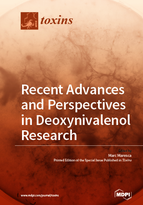Recent Advances and Perspectives in Deoxynivalenol Research
A special issue of Toxins (ISSN 2072-6651). This special issue belongs to the section "Mycotoxins".
Deadline for manuscript submissions: closed (20 December 2013) | Viewed by 186318
Special Issue Editor
Interests: mycotoxins; fungal metabolites; antimicrobial; anticancer; antinflammatory; antioxidant
Special Issues, Collections and Topics in MDPI journals
Special Issue Information
From many years, the food-associated trichothecene mycotoxin Deoxynivalenol (DON or vomitoxin) has attracted the attention of scientists (https://www.mdpi.com/2072-6651/5/4/784). This is due for part to its high prevalence in animal/human food and feed products as demonstrated through the successful use of urinary biomarkers confirming the exposure of humans to substantial doses of this toxin. DON is also one of the most hazardous mycotoxins, this toxin affecting the functions of nervous, endocrine, immune and intestinal cells. In addition to its toxicity to animal cells (that could be considered as a collateral damage), DON is also known to affect plant cells functions, such effects certainly playing a role during the colonization of wheat and cereals by DON-producing fungi such as Fusarium species. The toxicity of DON seems to depend on the presence an epoxide function allowing its binding to ribosomes, causing the so-called “ribotoxic stress” effect, the activation of specific kinases (including PKR and MAP kinases) and eventually leading to the inhibition of the protein synthesis and to cell death. Due to its ability to activate PKR and MAP kinases, DON also acts as a proinflammatory signal at low doses whereas higher doses are immunosuppressive due to cellular toxicity. In animals, in addition to affect the systemic and the intestinal immunity, DON also impacts the functions of the brain and endocrine cells, causing anorexia and vomiting. Food not only contains native toxin, but also large amounts of plant and fungal derivatives of DON (including the fungal metabolites 3 and 15 acetyl-DON (3 and 15ADON) and the plant derivative 3-O-glucoside-DON (D3G)) and possibly, although no study has yet confirmed it, of animal derivatives (i.e., 3 and 15-glucuronide DON) potentially present in meat and animal-derived products. New DON derivatives were furthermore recently found in plants and food products, including DON-oligoglycosides, DON-glutathione, DON-S-Cysteine, DON-S-Cysteinyl-glycine, DON-sulfonate. Although previous research has brought light on the mechanisms of action of DON, important questions remain. For example, little is known on the ability of the fungi to be transmitted from the soil to the cereals and on the levels of DON and DON metabolites in different plant tissues during natural and experimental contamination. Data on the effects of DON and its metabolites on plant cells are also scarce. Similarly, how DON enters the cells (animal or plant cells) and how it binds / acts on ribosomes is not perfectly characterized. Finally, if ribosomes are the only target of DON, how the toxin could activate different kinases depending of the dose of toxin remains a mystery. We hope some of these questions will be answered in this special issue focusing on one of the most studied and relevant food-associated mycotoxin.
Dr. Marc Maresca
Guest Editor
Manuscript Submission Information
Manuscripts should be submitted online at www.mdpi.com by registering and logging in to this website. Once you are registered, click here to go to the submission form. Manuscripts can be submitted until the deadline. All submissions that pass pre-check are peer-reviewed. Accepted papers will be published continuously in the journal (as soon as accepted) and will be listed together on the special issue website. Research articles, review articles as well as short communications are invited. For planned papers, a title and short abstract (about 100 words) can be sent to the Editorial Office for announcement on this website.
Submitted manuscripts should not have been published previously, nor be under consideration for publication elsewhere (except conference proceedings papers). All manuscripts are thoroughly refereed through a double-blind peer-review process. A guide for authors and other relevant information for submission of manuscripts is available on the Instructions for Authors page. Toxins is an international peer-reviewed open access monthly journal published by MDPI.
Please visit the Instructions for Authors page before submitting a manuscript. The Article Processing Charge (APC) for publication in this open access journal is 2700 CHF (Swiss Francs). Submitted papers should be well formatted and use good English. Authors may use MDPI's English editing service prior to publication or during author revisions.
Keywords
- deoxynivalenol
- trichothecene
- cell entry
- cell effect
- DON derivative







